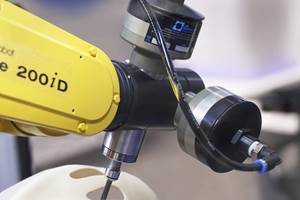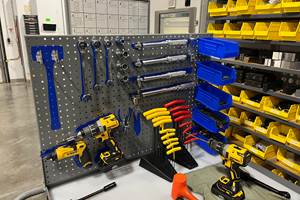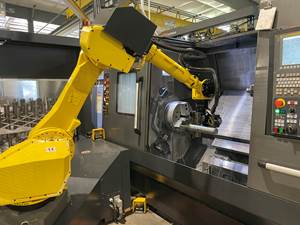Automation Helps Move To High-Volume Production
This tool manufacturer had to automate its processes after switching from low-volume special orders to high-volume production runs. Since implementing Tsudakoma tilting rotary tables along with robotics and a pallet conveyor, the shop has increased sales by 400 percent.
Share






RFM opened its doors in 1978 and specialized in custom-designed indexable cutting tools manufactured specifically for the automotive industry. After steadily growing for 20 years, everything changed for the Brighton, Michigan-based shop. In 1998, Mitsubishi Materials USA took notice of RFM’s tooling expertise and manufacturing capabilities and purchased the company. Following the acquisition, RFM had to move from manufacturing low-volume specials to high-volume production of indexable, multi-pocketed milling cutters, end mills and drills.
To accomplish this, the shop planned to expand its facility from 6,000 to 7,500 square feet; hire two additional CNC operators; upgrade its current equipment; and purchase new, state-of-the-art CNC machines. The first investment was to retrofit two existing Okuma VMCs with new Tsudakoma TRNCB-301 tilting rotary tables and TPC M-code controllers (distributed in North America by Koma Precision). The clamping torque and accuracy provided by the rotary tables ensured that the machines could meet tolerances. As production volumes increased, the company replaced its older VMCs with new Okuma models, which were also equipped with Tsudakoma tilting rotary tables.
The additional 1,500 square feet of floor space quickly became occupied with the new machines. However, the new machines and the addition of a second shift still did not provide the extra production capacity the company had estimated. It became evident that stand-alone machines could not satisfy inventory demands. RFM and Mitsubishi Materials realized they needed productivity innovation to grow the business and supply an expanding world market. "The solution had to provide more with less," says Rudy Meffert, vice president and general manager of RFM.
RFM invited Gosiger Michigan, the regional Okuma distributor, to lend its expertise and provide input during the decision-making process. By the end of the meeting, Gosiger fully understood what the shop wanted to accomplish. The obvious solution was to automate RFM’s production methods. The initial investment for automation approximately equaled the cost of another machining center, and the projected payback would be generated in less than 1 year.
In July 2007, Gosiger delivered an Okuma MB46VA; a Tsudakoma TN-200 tilting rotary table equipped with a hydraulic pullstud device; a Fanuc M16iB robot with six axes of articulation; a Fanuc R-J3iC controller; and a Gosiger automation system consisting of three pallets that accommodate 25 workpieces on a conveyor with a load/unload station.
In place for more than a year now, the new automation system has delivered the increased production capacity RFM needed. In addition to the daily capacity the system provides, the shop enjoys an average of 8 hours of unattended machining on nights and weekends. The system can also be expanded to meet any future production requirements. And according to Mr. Meffert, the robot forced the company’s staff to improve their setup techniques.
Overall, the shop has increased production by 25 percent with the addition of the robotic system and no changes to its manufacturing staff. In addition, the company is better able to provide on-time delivery to its warehouse in Los Angeles. Since 2000, when RFM first began its productivity program with an investment in Tsudakoma rotary tables, sales have increased by 400 percent.
Related Content
How to Accelerate Robotic Deburring & Automated Material Removal
Pairing automation with air-driven motors that push cutting tool speeds up to 65,000 RPM with no duty cycle can dramatically improve throughput and improve finishing.
Read MoreTranslating a Prototyping Mindset to Production
The experimental mindset that benefited BDE Manufacturing Technologies as a prototype job shop has given it an adaptable edge as a production facility.
Read MoreIncreasing Productivity with Digitalization and AI
Job shops are implementing automation and digitalization into workflows to eliminate set up time and increase repeatability in production.
Read MoreSame Headcount, Double the Sales: Successful Job Shop Automation
Doubling sales requires more than just robots. Pro Products’ staff works in tandem with robots, performing inspection and other value-added activities.
Read MoreRead Next
Last Chance! 2025 Top Shops Benchmarking Survey Still Open Through April 30
Don’t miss out! 91ÊÓƵÍøÕ¾ÎÛ's Top Shops Benchmarking Survey is still open — but not for long. This is your last chance to a receive free, customized benchmarking report that includes actionable feedback across several shopfloor and business metrics.
Read MoreMachine Shop MBA
Making Chips and 91ÊÓƵÍøÕ¾ÎÛ are teaming up for a new podcast series called Machine Shop MBA—designed to help manufacturers measure their success against the industry’s best. Through the lens of the Top Shops benchmarking program, the series explores the KPIs that set high-performing shops apart, from machine utilization and first-pass yield to employee engagement and revenue per employee.
Read MoreAMRs Are Moving Into Manufacturing: 4 Considerations for Implementation
AMRs can provide a flexible, easy-to-use automation platform so long as manufacturers choose a suitable task and prepare their facilities.
Read More




















